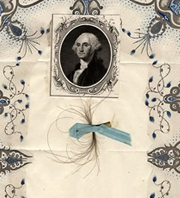Hair Club for Presidents
Joel Rose
FEBRUARY 16, 2008
- General Washington's Locks
- (Courtesy the Academy of Natural Sciences of Philadelphia)
- View the Slideshow
Web Resources
Related Stories
- New Langston Hughes Poems Discovered
- Conversations with America: Concluding the Conversation
- Weekend Soundtrack: "Shattered" by the Rolling Stones
- Saving the Story
More From Joel Rose
Hair wasn't Peter Browne's job. But it was his obsession. Browne was a lawyer and in his spare time, he filled dozens of leather-bound books with samples from people all over the world, including a dozen U.S. presidents.
"Each page shows not only the lock of hair -- tied in a delicate blue ribbon -- but also there's an engraved portrait of the president," says Robert Peck, a curator at the Academy of Natural Sciences.
To be honest, the little of snippets of presidential hair all look like the same mix of brown and gray, although Zachary Taylor's sample is curly, and Jefferson's hair does look sort of red. Peck says it wasn't that hard for Browne to get his samples. All he had to do was ask.
"He would write to presidents or former presidents and ask, straight out, 'Can I have a lock of your hair?' With those who had already died, like Thomas Jefferson and George Washington, he wrote to members of the family," he says.
Turns out the Victorians had a thing for hair. They would carry it around in lockets, turn it into jewelry, even stick it on to postcards and valentines. Peck says Peter Browne studied fur from animals before moving on to humans in the 1850s. Besides the presidents' hair, he got locks from the heads of Napoleon Bonaparte, Jefferson Davis and lots of other people you haven't heard of.
"He has collections here from people who were criminals. Who were insane. He tried to get the range of all of humanity. He hoped that perhaps the hair would reveal something about personalities or the inherent qualities of the people involved."
"Which is not ... " I interject.
"Which is definitely not true. We know now that physical attributes tell us nothing about personality," Peck agrees.
In that sense, Browne was clearly on the wrong track. But in other ways, he was ahead of his time.
Lou Szojka works for the Philadelphia Police Department in its forensic science lab. He says you can tell some basic things from looking at hair under a microscope: color and shape, for instance, which might give you some clues about the owner. But Szojka says the real treasure-trove of information is in the follicle.
"That's where nuclear DNA would be found. And we would need a nice root on the hair -- a bulbous root with a lot of genetic material -- in order for the DNA people to be successful in their tests."
Which means there's probably not a whole lot of new information you could get from the presidential hair samples on display at the Academy of Natural Sciences. But curator Robert Peck says they still have their charms.
"The Victorians found hair fascinating because it was the tangible remains of a loved one, or the keepsake of someone far away. So there was something very evocative. And I must say, it still has that effect today. This is as close as we will ever get to seeing George Washington or Thomas Jefferson ourselves."
But only for a brief moment. Then the presidential locks go back into the archives where they've been for almost 150 years.







Comments
Comment | Refresh
Post a Comment: Please be civil, brief and relevant.
Email addresses are never displayed, but they are required to confirm your comments. All comments are moderated. Weekend America reserves the right to edit any comments on this site and to read them on the air if they are extra-interesting. Please read the Comment Guidelines before posting.
You must be 13 or over to submit information to American Public Media. The information entered into this form will not be used to send unsolicited email and will not be sold to a third party. For more information see Terms and Conditions and Privacy Policy.